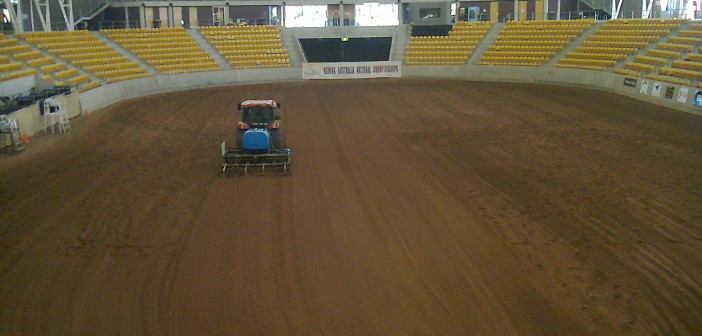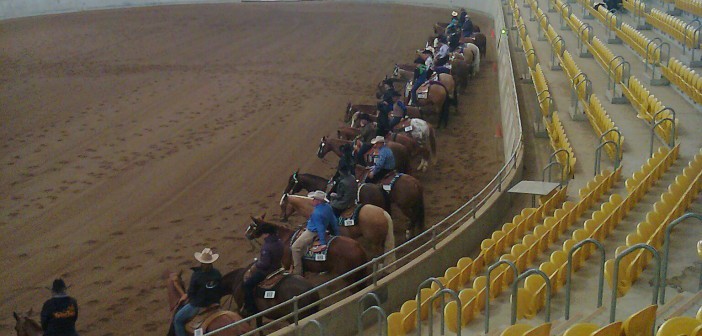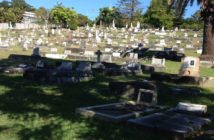The truck picks me up from the Brisbane airport and I’m instantly in another world. The light is harder and the visual landscape different. Fortunately it’s a Brisbane winter or spring and the usual blast of heat doesn’t hit me. The Brisbane surrounds always remind me of the early days of the outer North Shore of Auckland on speed.
The horsefloat is standing waiting outside the barn. Aware of its status and the subjugated place of cats in this part of rural Australia, some protected bird has decided to make its on the ground nest only feet away from the float and it screams, squawks and runs at me as I clean out the inside ready for the trip to Tamworth in Northern New South Wales. I have one eye on the bird, known for swooping and scratching as well as high volume verbals, as I wipe down the outside of the float and clean the inside of the truck. We pack; it’s mostly food and gear for the horse. There is a very small space allowance for people gear and clothing. I guide the truck towards the towbar: memories flood back. It’s unexpectedly morning cool as we lead the horse onto the float and start the drive to Northern New South Wales via rural Queensland and the tick spraying station.
Australia has a stringent, yes, aggressive attitude to biosecurity. My late mother Margaret regularly talked of the drubbing she got for taking an orange “off the boat” for baby me as we crawled along the sea towards our eventual home in New Zealand. Ironically I’m with the Australians and wish New Zealand was as staunch and harsh towards pest and disease incursion.
We almost miss the tick spraying station and drive in the wrong way, which we have done before, much to the delight of the tick sprayer who recognises us. Horse off the float and wearing what looks like a raincoat and gumboots the tick sprayer sprays the horse with some tick-toxic stuff. We talk with the next customer also on their way to NSW northern. Reload the horse and, remembering the baby orange incident, I file the tick-sprayed certificate in my handbag.
But its a wonderful drive through the hills, highlands and valleys. I see an Australia I’ve never seen before. Nothing like the surf coast or coastal fringe urban conglomerations. I instantly love this Australia. As we travel through long-established small towns I wonder how the early settlers actually got up here – how they built these houses and churches. They punctuate a drive that goes on for miles and miles through trees, grass, downed wood. I can actually see the Man from Snowy River riding through this landscape: hat back and coat tails flying.
Tamworth, northern New South Wales, Australia is exactly the kind of town a South Auckland and Waikato rural person could live in and would feel they’d never moved. I wait in the truck on the main road into town and watch as a huge tree overhanging a small building is slowly and methodically minimised.
Australian sky has no clouds – no clouds except in a storm
The sky is endless like the sky of a daylight planetarium
I wish you were here in my endless sky
The breeze-wind blows the pages
They are using a crane and a cherrypicker to cut down a large tree
which under this endless blue sky has grown unwantedly large
The sun has moved west past the tree –
The wind is blowing evening and darkness towards me
Why am I doing this – because I said I would.
It’s getting dark when we finally arrive; dinner would be nice. But we’re here for horses so he’s the first thing unloaded and off to his allocated stall and his dinner. Out of nowhere young people show up and help unload the gear, carry it from the float park to the tack room and stow it away. A man appears to remove the heavy metal float divider. I’m given the job of washing and sanitising the floor of the horse float – yes, we sleep in sleeping bags on stretchers in the back of the float. By the time it’s all made up and we’ve shared bacon and eggs at a nearby truck stop, the stretchers in the back of the float are the most beautiful accommodation I’ve ever seen. We’re high up altitude wise so all of a sudden we’re both wearing merino jumpers, wool socks and beanies to bed and a heater warms the float.

Equine & Livestock Arena Tamworth
The Australian Equine & Livestock Event Centre is huge; the Tamworth equivalent of the Colosseum, diminishing the Karaka thoroughbred sales complex I’m familiar with. The wide tarsealed roadway and parking areas are temporary home to a diverse range of horse transport and temporary accommodation, standard horse floats to huge articulated multi-horse transporters. Alongside these are often “all the comforts of home” including a large open fire pit which at night spits fireworks into the early black nights. There is a huge arena surrounded by endless loose boxes, washbays, tackrooms, toilets and shower blocks. High above the arena is a cafe selling food which reminds me of the downtown Auckland pie cart of yesteryear, gear shops and an administration office. Outside there are practice arenas and the Travelling Capucino man is doing a regular and roaring trade in paper-cupped caffeine.
Rural Australia is here. Affluent Australia is here. I meet a professional who talks about his place in the country and the person who looks after his horses: but I note he and his children know exactly what to do and how to work when it comes to caring for and preparing their horses. People whose business is horses are here: outside one or two of the stables are highly decorated and themed promotional areas. It’s Karaka deja vu.

Part of the hardstand
There are no surfboards but heavily used work boots, caps and jackets. I see gnarled hands and sun exposed skin and the beautiful jean-clad young. The personalities are the same you’d find anywhere – closed blank faces of the unmet and unknown and the overt happiness and friendliness of those we’ve previously met “hello kiwi chick”. It’s shared food and drinks, help with equipment and gear, free advice, smiles and hellos. Its leaning on the rail of the practice ring for boredom inducing periods of time and sitting high above the formal arena as dreams are made and lost in seconds. It’s as if I’ve brought Karaka, Matamata or Cambridge in my backpack except here the trees on the centre lawns are small, sad gums.
Competition days start early here. 4 am means get up, shampoo and groom the horse. Immaculate previously cleaned gear for the horse hangs ready and unique designer attire waits in plastic covers. It’s like any performance competition.
There is a veneer of contemporary Americana and traditional Aussie stock-man, but with a diversity of performance appearance and style from traditional ‘western’ attire, crystal encrusted accessories to sophisticated combinations of colour and pattern. Beneath the bling is a tradition of elegance and refined control – a bonding of horse and rider created over endless hours of practice and dedication by both. I’m told reining is popular in the United States and Europe. She tells me it originated in Mexico. It reminds me of traditional dressage, the Lipanzer horses of Vienna and the stately processions of mantilla wearing Spanish riders.

And the results are …
Like dressage there are compulsory elements to be included in the individual performance routines. They are predominantly balletic with horse and rider floating through combinations of grace, speed and movement. A failure or performance flaw creates an elimination score and hours, months and years of work and practice evaporate in an instant. I saw one beautifully performing combination eliminated when the horse shied at a shadow on the arena floor – heartbreaking. This is big money competition.
There are two judges seated on a high stand at the side of the arena. One looks like Wyatt Earp, funereally black-coated and hatted. The other wears Burberry. Two female ‘scribes’ sit at either side of the judges one white stetsoned and coated in ankle reaching black.
Parked next to us on the hard stand, also in a horse float, are a mother and her two daughters. They’ve travelled a very long way to be here. They are lovely neighbours. The older daughter and mother are both competitors. The mother is having a run of success. I watch with delight as, elegantly clad in a fringed black leather jacket it’s back silver studded with a Maltese cross, this quiet and unassuming younger woman decimates the competition. The family have been so nice to us I’m instantly vicariously proud. A second blue rosette follows and then, clad in a combination of a silver Deo de mortis skull embossed shirt she and her horse once again ace the others. My heart cracks and tears come to my eyes when some months later I open an envelope and see the Deo de mortis patterned scarf and note she has sent me.
Not every day is a competition day so, after working and feeding the horse, cleaning out the horse float, doing the washing and airing the bedding there is time to have a look around. With spare time, I walk along the highway past the imposing electrical sub-station into the shopping block and incongruously find a decorator store and an outlet store for an expensive brand of linen and homewares. Presents for cat sitters are bought.
I walk further down the road and come across The Tamworth Truck Drivers Memorial.
“dedicated to the men and women who have accidentally been killed while performing their duty as professional drivers and to those who dedicated their lives to the transport industry”
There are plaques and acknowledgements, toys and artificial flowers, there are nicknames “Fruit Fly”, “Chap”, “Cowboy”, :”Captain Vegemite”.
“May God make your miles safe…”
It adds another dimension to the life and role of the long-haul driver.
On a drive into Tamworth I also find a memorial park and bronze statues of those locals associated with the development of country music and the country music festival. It’s impossible to avoid the huge golden guitar, an eyewateringly large piece of public art, celebrating the country music festival for which the town is internationally known.
The streets of urban Tamworth are lined with trees intensifying the rurally charming character and ambience of the town. There are small versions of major chain stores alongside boutique shops crammed with delights. In one of the older buildings there is Markers Home Cookery. I’m instantly back in those childhood days of having to choose from the thick sloping glass cabinet holding those retro goodies – neenish tarts, custard slices, butterfly cakes, small hard meringues, flies cemeteries, sausage rolls, pies and sandwiches covered by damp muslin. Markers is the real deal. Original design, glass and wood display cabinets. Trays of cakes and goodies. The front window alive with cake decorations of the traditional kind. “it’s all baked on the premises” There are enormous custard squares and cream filled concoctions. It’s traditionally glorious and if I hadn’t just eaten lunch I’d have done more than look.
As a treat, I’m shouted lunch in the cafe Addimi. It’s really busy in here. We sit next to the best behaved baby in the world lunching with his Mum and Grandma. I have a salmon toasted wrap with salad leaves and the truck driver has crispy duck salad with raspberry vinaigrette. On the counter top behind us are large jars of substantial biscuits. In the very end jar are macadamia, fig and ginger biscuits. They are palm sized but I eat all this scrumptious thing with its hint of lemon and ginger. People have been coming into the cafe with bags from The Magic Pudding and The Lemon House. The former is long and narrow and bursting with all sorts of gifts and locally produced food and preserves. I’m bought a gift. Along the road in The Lemon House among the crowds of accessories I find my new bag.

Part of the hardstand
Cleaning up, packing up and driving home is almost as effort-intense as getting here in the first place. “It was snowing the last time we drove out of here” I have no difficulty in believing that to be true as we grind our way through the high altitudes. Its back through horticultural land, apple growing, past the Bolivia Station and advertisements for antiques. This time, I notice public art – large wire statues advertising towns down side roads or off the main highway. In an isolated area we find the modern version of the long drop toilet, “the dunny” of pre-procelain days. I’ve used worse toilets than these but the entire time I’m in there I’m waiting to be bitten by a spider or a snake. Bite free the journey back is resumed. We encounter a storm in a Karangahake like national park of rocks and huge boulders as we low gear down the steep road terrain in cold driving rain. Out of this Coromandel-like environment, suddenly we’re in the Brisbane back roads and the truck slows so I can jump out and open and close the gate. I’m tired, I’m dirty and my sneakers have had it. I didn’t realise it at the time, but this was “a trip of a lifetime.”
The Highway
How many dreams have fallen down
How much love has been wasted here on these old hard stones
How much sweat created and expended only to be beaten by this old hard land
How many children have died here, lost forever under these stones
Am I driving over your love, your loss, your dreams
This is a hard land.
Cunningham Highway 22nd September 2015
 Rosemary Balu. Rosemary Balu is the founding and current editor of ARTbop. Rosemary has arts and law degrees from the University of Auckland. She has been a working lawyer and has participated in a wide variety of community activities where information gathering, submission writing, community advocacy and education have been involved. Interested in all forms of the arts since childhood Rosemary is focused on further developing and expanding multi-media ARTbop as the magazine for all the creative arts in the Bay of Plenty, New Zealand.
Rosemary Balu. Rosemary Balu is the founding and current editor of ARTbop. Rosemary has arts and law degrees from the University of Auckland. She has been a working lawyer and has participated in a wide variety of community activities where information gathering, submission writing, community advocacy and education have been involved. Interested in all forms of the arts since childhood Rosemary is focused on further developing and expanding multi-media ARTbop as the magazine for all the creative arts in the Bay of Plenty, New Zealand.






